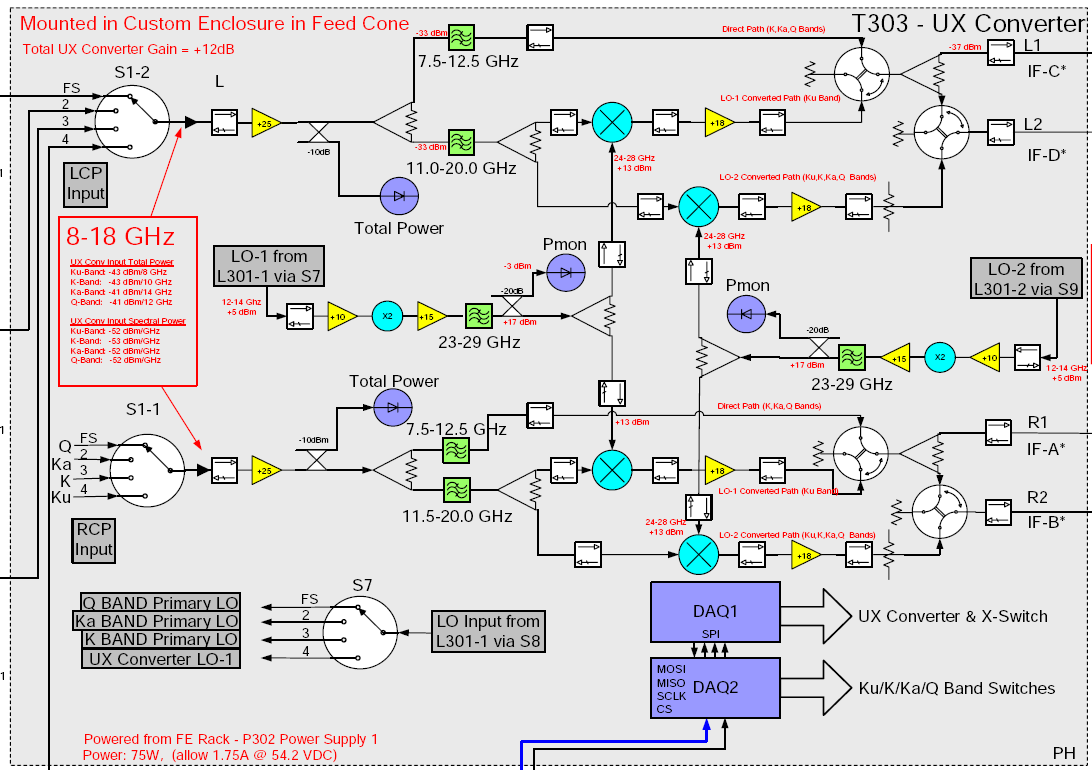| Overview | Package | Class | Use | Tree | Deprecated | Index | Help |

|

|
|||||||||
| PREV CLASS NEXT CLASS | FRAMES NO FRAMES | |||||||||
| SUMMARY: NESTED | FIELD | CONSTR | METHOD | DETAIL: FIELD | CONSTR | METHOD | |||||||||
java.lang.Objectedu.nrao.sss.model.resource.evla.T303
public class T303
The EVLA T303 UX Converter.
This device has two halves that are identical. Each half has a single input1, three internal pathways, and two outputs. There are two switches near the outputs that determine which pathways are output. One of these pathways filters the signal and uses no mixer. Each of the other two pathways uses a distinct local oscillator for mixing the input. Both of these oscillators are used for a single path in each of the two halves. That is, LO1 is used in one path in the top half, and in the parallel path in the bottom half, and likewise for L02.
As used by the EVLA electronics, the
top input carries left circular polarized signals that have come from
either the Q, Ka, K, or Ku band front ends. The bottom inputs are similar,
except that they carry RCP signals. Each of the four outputs is sent to
a different switch, the outputs of which are connected to different
T304 converters.

1In the diagram, switches S1-1 and S1-2 are shown as residing within the T303 UX converter. However, in this software model, those switches are considered to lie outside the T303.
Version Info:
| $Revision: 1706 $ |
| $Date: 2008-11-13 16:09:36 -0700 (Thu, 13 Nov 2008) $ |
| $Author: dharland $ (last person to modify) |
| Constructor Summary | |
|---|---|
T303(SignalSource LO1,
SignalSource LO2)
Creates a new T303 UX Converter that uses the given sources as its local oscillators. |
|
| Method Summary | |
|---|---|
void |
execute()
See SignalProcessor.execute(). |
void |
executeFromStartOfChainUpTo(SignalProcessor firstUnexecutedDevice)
See SignalProcessor.executeFromStartOfChainUpTo(SignalProcessor). |
void |
executeUpTo(SignalProcessor firstUnexecutedDevice)
See SignalProcessor.executeUpTo(SignalProcessor). |
SignalPipe |
getBottomInputPipe()
Returns the bottom input for this converter. |
List<SignalPipe> |
getBottomOutputPipes()
Returns the bottom outputs for this converter. |
FrequencyRange |
getDirectPathFilterPassBand()
Returns the pass band for the filter on the path that has no local oscillator. |
FrequencyRange |
getLocOsc1FilterPassBand()
Returns the pass band for the filter that is between the multiplier and mixer for local oscillator one. |
BigDecimal |
getLocOsc1Multiplier()
Returns the factor by which the signal from the LO-1 is multiplied. |
FrequencyRange |
getLocOsc2FilterPassBand()
Returns the pass band for the filter that is between the multiplier and mixer for local oscillator two. |
BigDecimal |
getLocOsc2Multiplier()
Returns the factor by which the signal from the LO-2 is multiplied. |
FrequencyRange |
getLocOscPathFilterPassBand()
Returns the pass band for the filter that is upstream of the two local oscillator pathways. |
Collection<Signal> |
getSignals()
Returns the signals produced by this converter. |
SignalPipe |
getTopInputPipe()
Returns the top input for this converter. |
List<SignalPipe> |
getTopOutputPipes()
Returns the top outputs for this converter. |
void |
setOutputSwitches(String output1,
String output2)
Sets internal switches that determine which internal pathways reach the outputs. |
| Methods inherited from class java.lang.Object |
|---|
clone, equals, finalize, getClass, hashCode, notify, notifyAll, toString, wait, wait, wait |
| Constructor Detail |
|---|
public T303(SignalSource LO1,
SignalSource LO2)
LO1 - provider of the LO-1 local oscillator signal.LO2 - provider of the LO-2 local oscillator signal.| Method Detail |
|---|
public SignalPipe getTopInputPipe()
public SignalPipe getBottomInputPipe()
public List<SignalPipe> getTopOutputPipes()
The returned list will contain two outputs. The output at index 0 will hold a signal that came either from the direct path, or from the LO-1 path. The output at index 0 will hold a signal that came either from the direct path, the LO-1 path, or the LO-2 path. The valid pairs of output pathways are:
The above pairs are dependent on the settings of this converter's
output switches.
public List<SignalPipe> getBottomOutputPipes()
The returned list will contain two outputs. The output at index 0 will hold a signal that came either from the direct path, or from the LO-1 path. The output at index 0 will hold a signal that came either from the direct path, the LO-1 path, or the LO-2 path. The valid pairs of output pathways are:
The above pairs are dependent on the settings of this converter's
output switches.
public void setOutputSwitches(String output1,
String output2)
LO1 (where "LO1"
is the first parameter of the constructor used to build this device), and a pathway that is mixed
with LO2. Only certain combinations are permitted, and are
as follows:
The above names are not case sensitive.
This method sets the top half and bottom half output switches in tandem. That is, if the top half is set to produce outputs LO1 / LO2, so is the bottom half.
output1 - the name of the pathway ("Direct", "LO1") to be sent through
the 0th output.output2 - the name of the pathway ("Direct", "LO1", "LO2") to be sent through
the 1st output.public Collection<Signal> getSignals()
public FrequencyRange getDirectPathFilterPassBand()
public FrequencyRange getLocOscPathFilterPassBand()
public FrequencyRange getLocOsc1FilterPassBand()
public FrequencyRange getLocOsc2FilterPassBand()
public BigDecimal getLocOsc1Multiplier()
public BigDecimal getLocOsc2Multiplier()
public void execute()
SignalProcessor.execute().
execute in interface SignalProcessorpublic void executeUpTo(SignalProcessor firstUnexecutedDevice)
SignalProcessor.executeUpTo(SignalProcessor).
executeUpTo in interface SignalProcessorpublic void executeFromStartOfChainUpTo(SignalProcessor firstUnexecutedDevice)
SignalProcessor.executeFromStartOfChainUpTo(SignalProcessor).
executeFromStartOfChainUpTo in interface SignalProcessor
|
|
|||||||||
| PREV CLASS NEXT CLASS | FRAMES NO FRAMES | |||||||||
| SUMMARY: NESTED | FIELD | CONSTR | METHOD | DETAIL: FIELD | CONSTR | METHOD | |||||||||